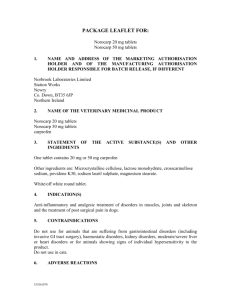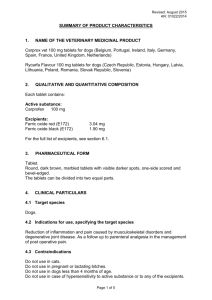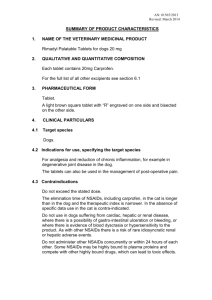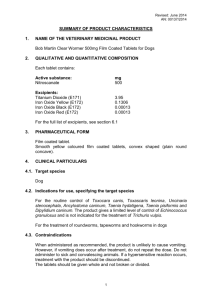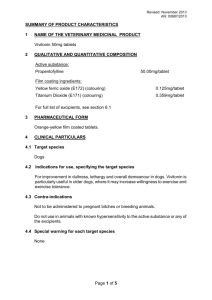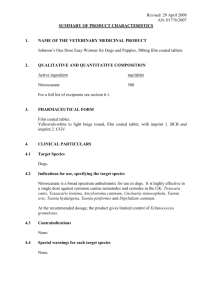United Kingdom Veterinary Medicines Directorate Woodham Lane
advertisement
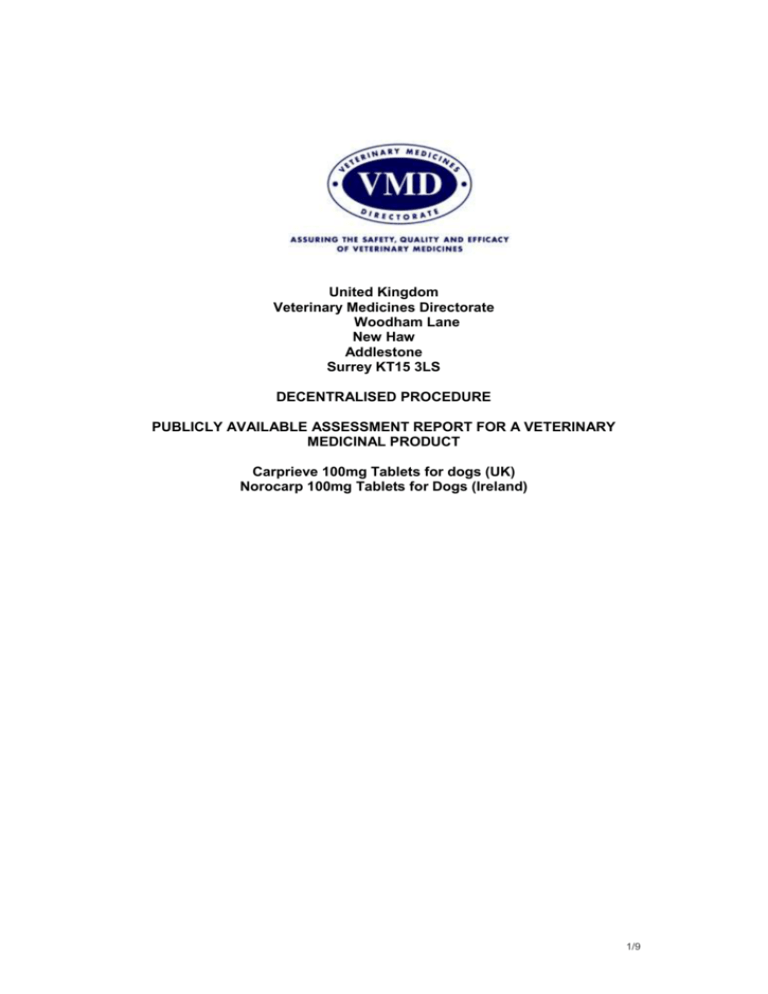
United Kingdom Veterinary Medicines Directorate Woodham Lane New Haw Addlestone Surrey KT15 3LS DECENTRALISED PROCEDURE PUBLICLY AVAILABLE ASSESSMENT REPORT FOR A VETERINARY MEDICINAL PRODUCT Carprieve 100mg Tablets for dogs (UK) Norocarp 100mg Tablets for Dogs (Ireland) 1/9 Carprieve 100 mg Tablets for dogs Norbrook Laboratories Limited UK/V/0317/001/DC Application for Decentralised Procedure Publicly Available Assessment Report MODULE 1 PRODUCT SUMMARY EU Procedure number UK/V/0317/001/DC Name, strength and pharmaceutical form Carprieve 100 mg Tablets for Dogs (UK) Norocarp 100 mg Tablets for Dogs (Ireland) Applicant Norbrook Laboratories Limited Active substance(s) Carprofen ATC Vetcode QM01AE91 Target species Dogs Indication for use Reduction of inflammation and pain caused by musculoskeletal disorders and degenerative joint disease. As a follow up to parenteral analgesia in the management of post operative pain. 2/9 Carprieve 100 mg Tablets for dogs Norbrook Laboratories Limited UK/V/0317/001/DC Application for Decentralised Procedure Publicly Available Assessment Report MODULE 2 The Summary of Product Characteristics (SPC) for this product is available on the Heads of Medicines Agencies (veterinary) (HMA(v)) website (www.hma.eu). 3/9 Carprieve 100 mg Tablets for dogs Norbrook Laboratories Limited UK/V/0317/001/DC Application for Decentralised Procedure Publicly Available Assessment Report MODULE 3 PUBLIC ASSESSMENT REPORT Legal basis of original application Application in accordance with Article 13(1) of Directive 2001/82/EC as amended. Date of completion of the original decentralised procedure 21 July 2009 Concerned Member States for Ireland original procedure I. SCIENTIFIC OVERVIEW Carprieve 100 mg Tablets for Dogs contains the active substance carprofen. This product is authorised to be used in dogs in the reduction of inflammation and pain caused by musculoskeletal disorders and degenerative joint disease and as a follow up to parenteral analgesia in the management of post operative pain. The product is administered orally and the dosage rate is 4 mg carprofen per kg bodyweight per day given as a single dose or in two equally divided doses. The daily dose may be reduced, subject to clinical response. The product is produced and controlled using validated methods and tests which ensure the consistency of the product released on the market. It has been shown that the product can be safely used in the target species and the slight reactions observed are indicated in the SPC. The product is safe for the user, the consumer of foodstuffs from treated animals and for the environment, when used as recommended. Suitable warnings and precautions are indicated in the SPC. The efficacy of the product was demonstrated according to the claims made in the SPC. II. QUALITY ASPECTS A. Composition The product contains carprofen as an active substance and tartrazine, microcrystalline cellulose, lactose monohydrate, croscamellose sodium, povidone K30, sodium laurilsulphate and magnesium stearate as excipients. The product is packaged in either polypropylene snap secure tubs containing 14, 30 or 100 tablets, sealed with a white low density polyethylene snap secure Cap, or Aluminium-Aluminium blister strips of 10 tablets in cartons containing 10, 20, 30, 50, 60, 70, 100, 140, 180, 200, 250, 280, 300, 500 or 1000 tablets The particulars of the containers and controls performed are provided and conform to the regulation. 4/9 Carprieve 100 mg Tablets for dogs Norbrook Laboratories Limited UK/V/0317/001/DC Application for Decentralised Procedure Publicly Available Assessment Report The choice of the formulation is justified. B. Method of Preparation of the Product The product is manufactured fully in accordance with the principles of good manufacturing practice from a licensed manufacturing site. Process validation data on the product have been presented in accordance with the relevant European guidelines. C. Control of Starting Materials The active substance carprofen is an established active substance and supporting data have been provided in the form of a European Drug Master File (EDMF). It is considered that the manufacturing process is adequately controlled and the active substance specification has been suitably justified. There are seven excipients used in the formulation and each has been used previously in veterinary medicines. Microcrystalline cellulose, lactose monohydrate, croscarmellose sodium, povidone K30, sodium laurilsulphate and magnesium stearate have monographs in the Ph. Eur. and each comply with the requirements of the current edition of the Ph. Eur. The applicant provided raw material specification for tartrazine (E102), comprising tests of appearance, loss on drying, pH, bulk density, dye content, free dye content, lead, arsenic, heavy metals and particle size. D. Specific Measures concerning the Prevention of the Transmission of Animal Spongiform Encephalopathies Scientific data have been provided and compliance with the Note for Guidance on Minimising the Risk of Transmitting Animal Spongiform Encephalopathy Agents via Human and Veterinary Medicinal Products has been satisfactorily demonstrated. E. Control on intermediate products Not applicable F. Control Tests on the Finished Product The finished product specification controls the relevant parameters for the pharmaceutical form. The tests in the specification, and their limits, have been justified and are considered appropriate to adequately control the quality of the product. The satisfactory validation data for the analytical methods have been provided. 5/9 Carprieve 100 mg Tablets for dogs Norbrook Laboratories Limited G. UK/V/0317/001/DC Application for Decentralised Procedure Publicly Available Assessment Report Stability Stability data on the finished product have been provided in accordance with applicable European guidelines, demonstrating the stability of the product throughout its shelf life. The shelf-life of the veterinary medicinal product as packaged for sale is 2 years. H. Genetically Modified Organisms Not applicable J. Other Information Special Precautions for Storage: Do not store above 25ºC. Store in a dry place. Protect from light. III. SAFETY AND RESIDUES TOXICOLOGICAL) ASSESSMENT (PHARMACO- Pharmacological Studies Since the application is made in accordance with Article 13 (1) of Directive 2001/82/EC as amended by Directive 2004/28/EC, on the basis of being a generic of a reference medicinal product, data on pharmacodynamics and pharmacokinetics are not required. Toxicological Studies Since the application is made in accordance with Article 13 (1) of Directive 2001/82/EC as amended by Directive 2004/28/EC, on the basis of being a generic of a reference medicinal product, data on toxicology are not required. User Safety The following operator warnings are included in the SPC and product literature: In the event of accidental ingestion of the tablets, seek medical advice and show the doctor the package leaflet. Wash hands after handling the product. Ecotoxicity The applicant provided a first phase environmental risk assessment in compliance with the relevant guideline. The assessment ended at Phase I as the products will only be used in dogs and exposure of the environment is not sufficient to require further assessment. The 6/9 Carprieve 100 mg Tablets for dogs Norbrook Laboratories Limited UK/V/0317/001/DC Application for Decentralised Procedure Publicly Available Assessment Report warnings and precautions as listed on the product literature are adequate to ensure safety to the environment when the product is used as directed. IV CLINICAL ASSESSMENT (EFFICACY) Pharmacology Pharmacodynamics The dossier refers to the data which were submitted for the reference medicinal product which included a series of published articles describing the chemical processes that lead to the development of inflammation in response to damage to cells in the body, as may happen in the case of degenerative joint disease in dogs. The damaged cells release a substance called arachidonic acid which may be converted into various other substances, such as the prostaglandins, which in turn cause an inflammatory response. These conversions are catalysed by various enzymes, one of which is called cyclo-oxygenase 2 (COX-2). It is thought that carprofen may exert its anti-inflammatory effect by inhibiting this enzyme so that the chain of reactions which leads to inflammation is broken. However, this may be only part of the mode of action; other actions, still to be elucidated, may also occur. Another member of the cyclo-oxygenase family, COX-1, is involved in normal cellular processes and it may be that carprofen’s low level of inhibition on this enzyme is the reason why it has fewer adverse effects on the gastro-intestinal system than some other NSAIDs. Most of the anti-inflammatory action of carprofen seems to derive from the Senantiomer. Pharmacokinetics Various published papers have shown that carprofen is rapidly absorbed into the bloodstream and readily penetrates and accumulates in acute inflammatory exudate. It is removed from the bloodstream quite slowly and this is responsible for its long duration of action. It is not distributed from the blood to normal tissues to any great extent but it may be metabolised in the liver by the addition of substances called glucuronides, and from here it may be excreted via the bile and faeces. To supplement the published information, the company commissioned a bioequivalence study, i.e. a study in which carprieve tablets were compared with a product that is already authorised, in terms of how much of the active ingredient, carprofen, was absorbed into the bloodstream when the products were given by mouth, as recommended. The study utilised a well-accepted study design known as a “crossover” design. The comparative study demonstrated that the product is bioequivalent to the reference product in terms of Cmax and AUC values. The Cmax and AUC values were within the tighter confidence intervals of 80-125 % as stated in the guideline EMEA/CVMP/016/00. 7/9 Carprieve 100 mg Tablets for dogs Norbrook Laboratories Limited UK/V/0317/001/DC Application for Decentralised Procedure Publicly Available Assessment Report Tolerance in the Target Species of Animals The company submitted the report of a new study commissioned in accordance with GLP to investigate whether the product was well-tolerated in dogs. The study concluded that the product has a good margin of safety and is welltolerated by dogs even if accidentally overdosed. Resistance Not applicable Clinical Studies A series of published documents was presented, in which the efficacy of carprofen containing product was investigated in various circumstances. One study demonstrated that a daily dose greater than 2.2 mg carprofen was required for efficacy. Several studies particularly focused on the use of carprofen in dogs with osteoarthritis. In each case, a significant number of dogs was found to respond favourably to the treatment. Similar results were found when carprofen was given to dogs prior to surgery to reduce postoperative pain in various different procedures, e.g. ovariohysterectomy or orthopaedic surgery. One study showed the efficacy of carprofen as an ocular anti-inflammatory drug. V OVERALL CONCLUSION AND BENEFIT– RISK ASSESSMENT The data submitted in the dossier demonstrate that when the product is used in accordance with the Summary of Product Characteristics, the risk benefit profile for the target species is favourable and the quality and safety of the product for humans and the environment is acceptable. 8/9 Carprieve 100 mg Tablets for dogs Norbrook Laboratories Limited UK/V/0317/001/DC Application for Decentralised Procedure Publicly Available Assessment Report MODULE 4 POST-AUTHORISATION ASSESSMENTS The SPC and package leaflet may be updated to include new information on the quality, safety and efficacy of the veterinary medicinal product. The current SPC is available on the Product Information Database of the Veterinary Medicines Directorate website. (www.gov.uk/check-animal-medicine-licensed) The post-authorisation assessment (PAA) contains information on significant changes which have been made after the original procedure which are important for the quality, safety or efficacy of the product. The PAA for this product is available on the Product Information Database of the Veterinary Medicines Directorate website. (www.gov.uk/check-animal-medicine-licensed) 9/9
